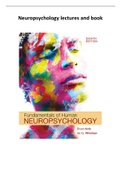Class notes
Extensive notes of the lectures and book (8th edition) Neuropsychology
- Course
- Institution
- Book
This document contains extensive notes of all the lectures and summaries of the subjects in the book that are not discussed during the lecture. A lot of pictures are included with explanations. Also, at the end the practice exam is discussed. I had a 9.1 for the exam with learning these notes.
[Show more]




